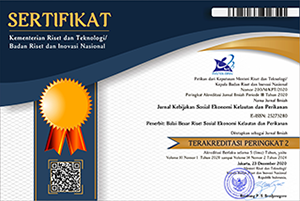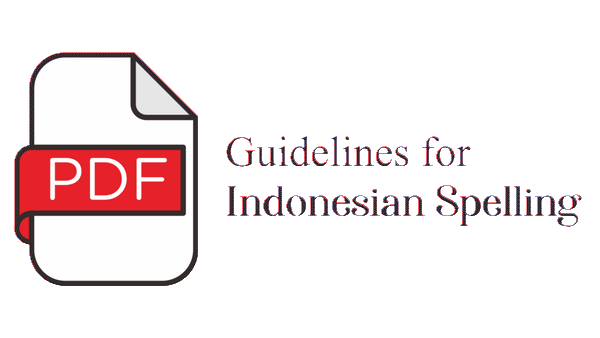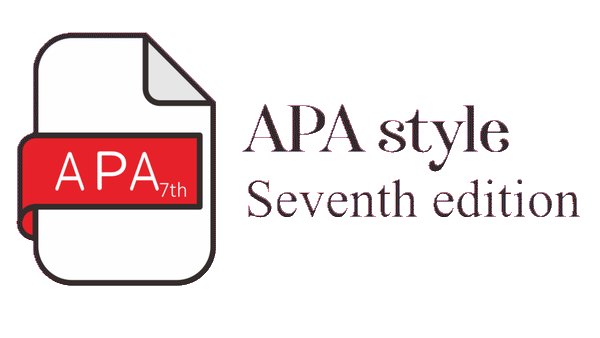MENCAPAI KEBERLANJUTAN EKOSISTEM LAUT MELALUI MARINE SPATIAL PLANNING (MSP): MUNGKINKAH?
Abstract
Pesisir dan laut telah sejak kala mengalami tekanan aktivitas manusia sehingga mengancam keberlanjutan fungsi-fungsi ekosistem di dalamnya. Seiring dengan berjalannya waktu, perhatian terhadap masalah ini menjadi semakin besar dan melahirkan konsep-konsep keberlanjutan pada wilayah pesisir dan laut seperti Marine Spatial Planning (MSP). Tulisan berikut mengeksplorasi konsepsi MSP dan hambatan yang dihadapi dalam tinjauan prosedur perencanaan. Metode yang digunakan adalah systematic review dalam rangka mengidentifikasi, mengevaluasi dan menginterpretasi berbagai literatur atau hasil kajian terkait. Hasil yang diperoleh menunjukkan adanya problematika empiris untuk diimplementasikan dalam tataran praktis. Idealisme MSP yang menggabungkan pendekatan komprehensif dan partisipatif akan menghadapi berbagai rintangan mulai dari ketiadaan data dan informasi, terbatasnya pengetahuan, keterikatan terhadap nilai dan budaya, sampai dengan isu dominasi kekuasaan atas suatu perencanaan yang bersifat kolaboratif. Penulis berargumentasi bahwa perencana perlu memberikan perhatian terhadap kekuasaan dan mampu mengontrol kekuasaan tersebut. Hal ini diperlukan agar kelemahan konsep MSP dapat tertutup dengan keberpihakan kekuasaan terhadap isuisu keberlanjutan.
Title: Achieving Marine Ecosystem Sustainability Through Marine Spatial Planning (MSP): Is it possible?
Since a long time ago, the coast and the sea have undergone hard pressure from human activities that threaten the sustainability of the ecosystem functions. As time goes by, the attention to this problem becomes greater and creates sustainability concepts in coastal and marine areas such as MSP. The following article explores MSP conceptions and its theoretical problems by reviewing the planning procedures. The method used in this study is a systematic review in order to identify, evaluate and interpret various literatures or results of related studies. The results indicate a theoretical weakness to be implemented. The idealism of MSP which combines a comprehensive and participatory approach will face various obstacles starting from the absence of data and information, limited knowledge, attachment to value and culture, to the issue of domination of power over a collaborative plan. I argues that planners need to pay attention to power and take control of it. This is necessary so that the weakness of the MSP concept can be covered by the alignment of power towards sustainability issues.
Keywords
Full Text:
PDFReferences
Aldo L. (1949). A Sand County Almanac, Ballantine Books. New York. Altshuler, A. (1965). THE GOALS OF COMPREHENSIVE PLANNING, Journal of the American Institute of Planners, 31:3, 186-195.
Anonim. (2015). Sail Tomini Perlu Sosialisasi
Lebih Gencar, Agar Wisatawan Dalam Dan
Luar Negeri Mengetahui Tentang Teluk
Tomini – yang Merupakan Bagian Dari Segitiga Terumbu Karang Dunia Taman Nasional Laut Kepulauan Togean atau Dikenal Sebagai
The Heart Of Coral Triangle. http://presidenri. go.id/program-prioritas-2/maksimalkan- potensi-wisata-bahari-indonesia.html.
Diakses tanggal 11 November 2018.
Becker G.S. (1976). The Economic Approach for Human Behaviour. The University of Chicago PressChicago and London.
Caitlin M.C., S.H. Benjamin, W. Mike & V.K. Carrie. (2009). The Year in Ecology and Conservation Biology: Ann. N.Y. Acad. Sci. 1162: 39–62 (2009). doi: 10.1111/j.17496632.2009.04496.
Daniels, T. (2014). Environmental Planning Handbook. New York: Routledge. Douvere, F. (2008). The importance of marine spatial planning in advancing ecosystem-
based sea use management. Marine Policy, 32 (2008) 762–771. doi:10.1016/j. marpol.2008.03.021.
Douvere, F. & Ehler, C.N. (2009). New perspectives on sea use management: Initial findings from European experience with marine spatial planning. Journal of Environmental Management, 90 (2009) 77–88. doi:10.1016/j.jenvman.2008.07.004.
Ehler, C. (2011). Marine Spatial Planning: An Introduction. MSP Generic Briefing 30 May-1 Juni 2011. Intergovernmental Oceanographic Commission. UNESCO. Paris, France.
Friedmann, J. (2008). ‘The Uses of Planning Theory: A Bibliographic Essay’, Journal of Planning Education and Research, 28(2), pp. 247–257. doi: 10.1177/0739456X08325220.
Foley M.M, S.H. Benjamin, F. Micheli, M.H. Armsby, M.R. Caldwell, C.M. Crain, E. Prahler, Ni. Rohr, D. Sivas, M.W. Beck, M.H. Carr, L.B. Crowder, J.E. Duffy, S.D. Hacker & K.L. McLeo. (2010). Guiding ecological principles for marine spatial planning. Marine Policy, 34(5), 955–966. https:// doi.org/10.1016/j.marpol.2010.02.001.
Healy, P. (1997). Collaborative Planning: Shaping Places in Fragmented Societies. Macmillan Education UK.
Healy, P. (2003). Collaborative planning in perspective. Journal of Planning Theory, Vol 2(2): 101–123. Sage Publication.
Hendler, S .(1995). Planning Ethics a Reader in Planning Theory, Practice, and Education.
Innes J.E. (1996). Planning Through Consensus Building: A New View of the Comprehensive Planning Ideal. Journal of the American Planning Association, 62:4, 460-472, DOI: 10.1080/01944369608975712.
Jones. P.J.S. (2014). Governing Marine Protected
Areas. Resilience Through Diversity. Routledge. New York. Kay, R. & J.
Alder. (1999). Coastal Planning and Management. Routledge. USA p. 345.
Kent, T.J. (1964). The Urban General Plan. San Francisco: Chandler Publishing Company. 1991.2nd Edition. Chicago, IL: Planners Press, American Planning Association.
Kitchenham, B. (2004). Procedures for Performing Systematic Reviews. Eversleigh: Keele University.
Liberati A, G.A. Douglas, J. Tetzlaff, C. Mulrow, P.C. Gøtzsche, J.P.A. Ioannidis, M. Clarke, P.J. Devereaux, J. Kleijnen & D. Moher. 2009. The PRISMA Statement for Reporting Systematic Reviews and Meta-Analyses of Studies That Evaluate Health Care Interventions: Explanation and Elaboration. Journal of Clinical Epidemiology, 62. 31-e34. doi: 10.1016/j.jclinepi.2009.06.00.
Lindblom, C.E., & D. Braybrooke. (1963). A Strategy of Decision: Policy Evaluation as a Social Process. New York: The Free Press, Macmillan.
Livinski, A., D. Joubert & N. Terry. (2015). Undertaking a Systematic Review: What You Need to Know [presentation]. Office of Research Services. National Institutes of Health. US Departement of Health and Human Services. USA.
Lotze, H.K., H.S. Lenihan, B.J. Bourque, R.H. Bradbury, R.G. Cooke, M.C. Kay, S.M. Kidwell , M.X. Kirby, C.H. Peterson & J.B. Jackson. (2006). Depletion, degradation, and recovery potential of estuaries and coastal seas. Science 312: 1806– 1809.
Mahmud A, A. Satria & R.A. Kinseng. (2015). Zonasi Konservasi untuk Siapa? Pengaturan Perairan Laut Taman Nasional Bali Barat. Jurnal Ilmu Sosial dan Ilmu Politik. Vol. 18 No.3 Maret 2015. Hal. 237-251. ISSN 1410-4946.
Margerum, R.D. (2002). Collaborative Planning: Building Consensus and Building a Distinct Model for Practice. Journal of Planning Education and Research, 21(3), 237–253. https://doi. org/10.1177/0739456X0202100302.
McCann, J., S. Schumann, G. Fugate, S. Kennedy & C. Young. (2013). The Rhode Island Ocean Special Area Management Plan: Managing Ocean Resources Through Coastal and Marine Spatial Planning. University of Rhode Island Coastal Resources Center/Rhode Island Sea Grant College Program,
Narragansett, R.I. Mujio, L. Adrianto, K. Soewardi & Y. Wardiatno. (2016). Analisis Potensi Konflik Pemanfaatan Ruang Kawasan Pesisir: Integrasi Rencana Tata Ruang Darat Dan Perairan Pesisir. Jurnal Sosiologi Pedesaan | Agustus 2016, hal 139-144.
Nunes, P.A.L.D., J.C.J.M. van den Bergh & P. Nijkamp. (2000). Ecological Economic Analysis. Economic Analysis and Valuation of Biodiversity and Valuation of Biodiversity. Edward Elgar Publishing Ltd. UK.
Owens, S. & Cowell, R. (2011). Land and Limits. London: Routledge.
Smith H.D., F. Maes, T.A. Stojanovic & R.C. Ballinger. (2011). The Integration of Land and Marine Spatial Planning. J Coast Conservation, 15: 291-303. DOI: 10.1007/s11852-010-0098-z.
Silberstein, C.M. & C. Masser. (2014). Planning For Sustainable Development (Second edition). CRC Press. Taylor & Francis Group.
Stein J.M. (2001). Classic Reading in Urban Planning: An Introduction. Island Press, 1718 Connecticut Avenue, N.W., Suite 300, Washington, DC.
Sullivan E.J. (2008). Recent Developments in Comprehensive Planning Law Edward J. Sullivan. The Urban Lawyer, Vol. 40, No. 3 (Summer 2008), pp. 549-559.
Suryanti. (2010). Degradasi Pantai Berbasis Ekosistem di Pulau Karimunjawa Kabupaten Jepara [Disertasi]. Universitas Diponegoro.
Swyngedouw, E. (2007). Impossible “sustainability” and the postpolitical condition. The sustainable development paradox: urban political economy in the United States and Europe, 13–40.
Tafon, R. V. (2018). Taking power to sea: Towards a post-structuralist discourse theoretical critique of marine spatial planning. Environment and Planning C: Politics and Space, 36(2), 258–273. https:// doi.org/10.1177/2399654417707527.
Thomas M. J. (1979). The procedural planning theory of A. Faludi, Planning Outlook, 22:2, 72-76, DOI: 10.1080/00320717908711582.
Undang-Undang Republik Indonesia Nomor 26 Tahun (2007) Tentang Penataan Ruang. Lembaran Negara Republik Indonesia Nomor 4725.
Undang-Undang. No. 1 Tahun (2014) Tentang Perubahan Atas Undang-Undang Nomor 27 Tahun 2007 Tentang Pengelolaan Wilayah Pesisir Dan Pulau-Pulau Kecil. Lembaran Negara Republik Indonesia Nomor 5490.
Undang-Undang Republik Indonesia Nomor 23 Tahun (2014) Tentang Pemerintahan Daerah. Lembaran Negara Republik Indonesia Nomor 5587.
Undang-Undang Republik Indonesia Nomor 32 Tahun (2014) Tentang Kelautan. Lembaran Negara Republik Indonesia Nomor 5603.
UNESCO. (2018). MSP World Application: Overview. http://msp.ioc-unesco.org/world-applications/ overview/. Diakses tanggal 1 November 2018. Yurista A.P. & D.A. Wicaksono. (2017). Kompatibilitas Rencana Zonasi Wilayah Pesisir Dan Pulau-Pulau Kecil (Rzwp3k) Sebagai Rencana Tata Ruang Yang Integratif. Rechts Vinding, Vo. 6 No. 2. ISSN: 2089-9009.
WCED. (1987). Our Common Future. United Nation Wheeler, S. (2004). Planning for Sustainability: Creating Livable, Equitable, and Ecological Communities. Routledge. London.
DOI: http://dx.doi.org/10.15578/jksekp.v9i1.7420
Indexed by:
---------------------------------------------------------------------------------------
Published by
Research Center for Marine and Fisheries Socio-Economic
in collaboration with
Indonesian Marine and Fisheries Socio-Economics Research Network
This work is licensed under a Creative Commons Attribution-NonCommercial-ShareAlike 4.0 International License.













3.png)











